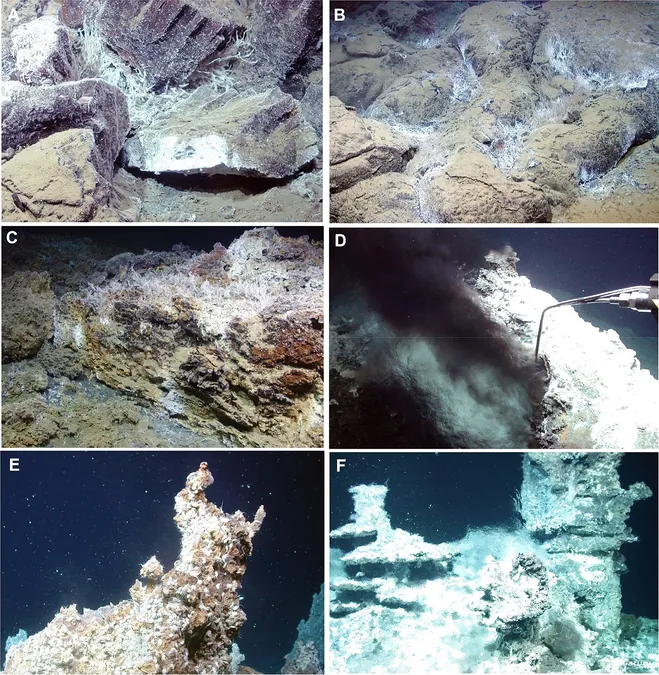
Shocking Discovery in the Arctic: 'Black Smokers' Found in Unexpected Depths!
2025-05-31
Author: Jia
Uncharted Waters of the Arctic
In the frigid heart of the Arctic, where temperatures barely rise above freezing and ice chokes the seas, you might assume little life thrives beneath the surface. But three years ago, an intrepid research team ventured into this dark abyss on a hunt for something extraordinary—a hydrothermal vent field called Jøtul.
A Historic Find
Nestled nearly 1.9 miles below sea level along the 311-mile stretch of the Knipovich Ridge between Greenland and Svalbard, Jøtul represents a groundbreaking discovery: the first hydrothermal vents revealed in this remote region. These remarkable vents, where seawater interacts with magma, deliver steaming, mineral-heavy fluids that can reach temperatures hot enough to melt lead.
Breaking Expectations
Traditionally thought to be barren, slow-spreading ridges like Knipovich have surprised scientists. Instead of appearing where magma pushes through the crust, the Jøtul vents are offset, suggesting unique geological processes at play. This discovery opens the door for future explorations suggesting many more such Arctic vents remain hidden, waiting to be uncovered.
Game-Changing Technology
Robotic technology played a crucial role in locating these mysterious vents. In 2021, an autonomous underwater vehicle detected unusual chemical spikes in water samples. Following up with the remotely operated vehicle MARUM-QUEST revealed a spectacular underwater landscape—metallic particles raining from the black smokers, an awe-inspiring sight.
Methane: A Climate Alarm?
What sets Jøtul apart is not just its location, but the exceptionally high levels of methane found in its fluids. This finding raises crucial questions about climate impact, as methane is a potent greenhouse gas. The discovery indicates that deep-sea processes might be contributing to the global carbon cycle in ways previously unrecognized.
Life Thrives in Darkness
Despite the complete absence of sunlight, life abounds around these vents. Communities of organisms—from limpet snails to specialized worms—live off chemosynthesis, turning chemicals from the vents into energy. This challenges previous notions about where life could evolve on Earth, suggesting these Arctic vents may be home to unique species adapted to extreme conditions.
What's Next for Jøtul?
The research team will return to the site later this summer with enhanced equipment, aiming to delve deeper into the Jøtul ecosystem. By mapping the seafloor and studying the vents' dynamics, they hope to unveil more secrets of this extraordinary habitat.
A New Frontier in Ocean Exploration
As our understanding of the Earth's ocean floor expands, the Arctic could transform from an overlooked area into a vital research frontier. The discovery of Jøtul exemplifies nature’s ability to hide incredible phenomena beneath layers of ice, pushing us to explore further and challenge our existing knowledge about our planet.
Stay tuned, as the story of Jøtul is just beginning! This odyssey into the depths is not only a testament to human curiosity and ingenuity, but it also holds the potential to reshape our understanding of life and climate on Earth.
For those who want to dive even deeper into the latest discoveries like Jøtul, subscribe to our newsletter and stay updated on future revelations!

 Brasil (PT)
Brasil (PT)
 Canada (EN)
Canada (EN)
 Chile (ES)
Chile (ES)
 Česko (CS)
Česko (CS)
 대한민국 (KO)
대한민국 (KO)
 España (ES)
España (ES)
 France (FR)
France (FR)
 Hong Kong (EN)
Hong Kong (EN)
 Italia (IT)
Italia (IT)
 日本 (JA)
日本 (JA)
 Magyarország (HU)
Magyarország (HU)
 Norge (NO)
Norge (NO)
 Polska (PL)
Polska (PL)
 Schweiz (DE)
Schweiz (DE)
 Singapore (EN)
Singapore (EN)
 Sverige (SV)
Sverige (SV)
 Suomi (FI)
Suomi (FI)
 Türkiye (TR)
Türkiye (TR)
 الإمارات العربية المتحدة (AR)
الإمارات العربية المتحدة (AR)